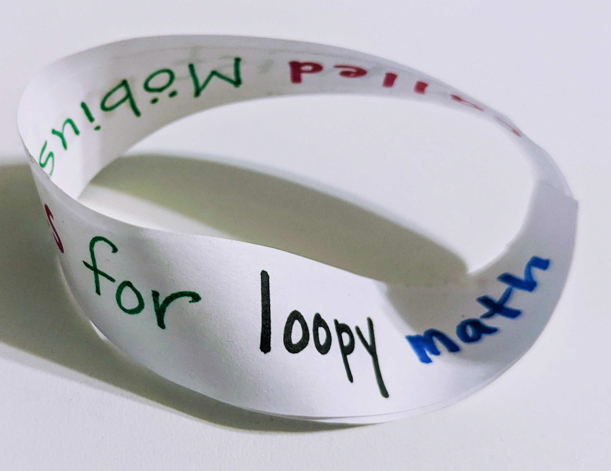BOOMbox at Home: Topology Activities
June 4, 2020

This week’s online BOOMbox features undiscovered and crafty challenges with materials you can find at home.
Exploring Topology
Take a rubber band or a hair tie and stretch it. Push it into a different shape. Flip it inside out. Is it still the same rubber band?
Cut the band in half with scissors. Is it still the same rubber band, or is it a rubber string now?
Now think about a cupcake liner or a shower cap. Consider the shape of the cupcake liner or the shower cap when you don’t do anything to them--what shape are they when you flatten them out? Does that mean that a cupcake liner or a shower cap is the same as a dinner plate?
There are no right or wrong answers to these questions, because math can be philosophical, too!
These questions form a part of the field of topology, an area of math where mathematicians explore how shapes and objects can change. Topologists say that cupcake liners are absolutely the same as dinner plates, cubes are the same as spheres, and there are some that even say that donuts are the same thing as coffee mugs!
Can you find other objects around the house that have the same shape as each other? You can be as flexible and creative as you want. Take inspiration from this video, which shows why topologists think that the human body is the same shape as two glass loops linked together.
Make a Möbius Strip
Is it possible to draw a line across two sides of a single sheet of paper without turning the page over? How about turning two loops of paper into a square? Do these sound impossible? Gather some paper, a pen, and scissors and give these activities a try.
You might have played around with strips of paper in the past by twisting them and connecting the ends together with glue or tape. If you did, you might have made a Möbius or Moebius strip. A Möbius strip is a loop with a single twist in it.
Unlike a normal piece of paper, which has two sides, Möbius strips have only one side. This means that you can do all sorts of weird and seemingly impossible things with Möbius strips. You can draw a line across the inside and the outside of the strip without taking your pen off the paper, make a square out of two circles, or tell a twisty, reversible story like that of Wind and her friend Mr Ug. You can also keep it simple and display your Möbius strips with a hanging mobile.
When making your Möbius strips, think about how many times you have to twist the paper before connecting the ends together:
- Does the loop still have only one side if you twist the paper more than once
- What happens when you cut a normal paper loop in half along the middle?
- Does the same thing happen when you do the same thing to a Möbius strip?
Here’s a serpentine verse to get your wheels (better yet - Möbius strips) turning: “Strips of paper with a twist make for loopy math called Möbius strips of paper with a twist makes for loopy math called Möbius....”
Make a Klein Bottle
A Möbius strip has one edge. If you connect the edges of two Möbius strips together, you will end up with an object that has no edges! This object is called a Klein bottle. Try taking two Möbius strips, with the twists in each strip going in opposite directions, and connect them together. You can use paper, fabric or plastic--whatever you have on hand that is bendy.
Did you manage to make a Klein bottle? If you found it very hard to make one, it’s because Klein bottles are impossible in real life. Klein bottles are 4 dimensional objects, which means that we can’t create one in our 3 dimensional world.
However, some people have managed to make Klein bottles by bending the rules a bit. They’ve used materials like glass, paper, and knitting yarn. You can bend the rules, too, and make your own Klein bottle with a pair of jeans that doesn’t fit you anymore or a pair of sleeves from an old shirt. What makes your Klein bottle similar to a real Klein bottle? What makes it different?
Scientist of the Week
Eugenia Cheng loves using bagels, slinkies, and playdough to illustrate how math and topology can be fascinating. She is scientist-in-residence at the School of the Art Institute of Chicago, where she teaches classes on how to look at math in a creative way and how to use math in art. She has even appeared on the Late Show with Steven Colbert, where she showed him how to use exponential calculations to make a delicious pie.
Share
We’d love to see the results of your experiments! Tag @skokielibrary when you share photos of what you’ve created on social media.
This week's post was written by Michelle and Veena.